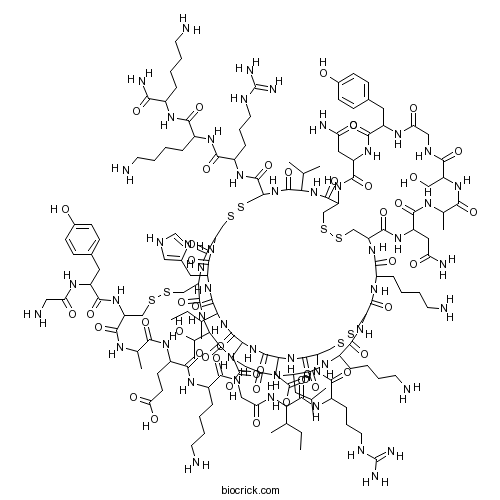Purotoxin 1Potent P2X3 modulator CAS# 1396322-38-5 |

- CX-5461
Catalog No.:BCC3700
CAS No.:1138549-36-6
- Gemcitabine HCl
Catalog No.:BCC1076
CAS No.:122111-03-9
- Fludarabine Phosphate (Fludara)
Catalog No.:BCC3681
CAS No.:75607-67-9
- Bleomycin Sulfate
Catalog No.:BCC3694
CAS No.:9041-93-4
Quality Control & MSDS
3D structure
Package In Stock
Number of papers citing our products

| Cas No. | 1396322-38-5 | SDF | Download SDF |
| PubChem ID | 90488991 | Appearance | Powder |
| Formula | C155H249N51O47S8 | M.Wt | 3835.47 |
| Type of Compound | N/A | Storage | Desiccate at -20°C |
| Solubility | Soluble to 1 mg/ml in water | ||
| Sequence | GYCAEKGIRCDDIHCCTGLKCKCNASGYNC (Modifications: Disulfide bridge: 3-16,10-21,15-32, 23-30) (Modifications: Lys-35 = C-terminal amide) | ||
| SMILES | CCC(C)C1C(=O)NC(C(=O)NC2CSSCC3C(=O)NC(C(=O)NC4CSSCC(C(=O)NC(C(=O)NC(CSSCC(C(=O)NC(CSSCC(C(=O)NC(C(=O)NC(C(=O)NC(C(=O)NCC(=O)N1)CCCCN)CCC(=O)O)C)NC(=O)C(CC5=CC=C(C=C5)O)NC(=O)CN)C(=O)NC(C(=O)NCC(=O)NC(C(=O)NC(C(=O)N3)CCCCN)CC(C)C)C(C)O)NC(=O)C(NC(=O)C(NC(=O)C(NC(=O)C(NC2=O)CC(=O)O)CC(=O)O)C(C)CC)CC6=CNC=N6)C(=O)NC(CCCNC(=N)N)C(=O)NC(CCCCN)C(=O)NC(CCCCN)C(=O)N)C(C)C)NC(=O)C(NC(=O)C(NC(=O)CNC(=O)C(NC(=O)C(NC(=O)C(NC4=O)CC(=O)N)C)CO)CC7=CC=C(C=C7)O)CC(=O)N)CCCCN)CCCNC(=N)N | ||
| Standard InChIKey | KECTXGMVIXOQAO-UHFFFAOYSA-N | ||
| Standard InChI | InChI=1S/C155H249N51O47S8/c1-12-75(7)120-152(252)188-91(32-25-49-171-155(167)168)132(232)197-105-67-256-255-65-103-143(243)186-89(30-18-23-47-160)131(231)196-104-66-257-260-70-108(200-139(239)98(55-111(163)212)189-136(236)95(52-81-35-39-84(210)40-36-81)180-113(214)60-173-127(227)101(63-207)194-125(225)78(10)176-134(234)97(54-110(162)211)190-145(104)245)148(248)204-119(74(5)6)151(251)202-107(144(244)187-90(31-24-48-170-154(165)166)129(229)184-87(28-16-21-45-158)128(228)181-85(123(164)223)26-14-19-43-156)69-259-258-68-106(199-138(238)96(53-82-59-169-72-175-82)193-153(253)121(76(8)13-2)205-141(241)100(57-118(221)222)191-140(240)99(56-117(219)220)192-146(105)246)147(247)201-109(149(249)206-122(79(11)208)150(250)174-61-114(215)179-93(50-73(3)4)135(235)185-88(130(230)195-103)29-17-22-46-159)71-261-254-64-102(198-137(237)94(178-112(213)58-161)51-80-33-37-83(209)38-34-80)142(242)177-77(9)124(224)182-92(41-42-116(217)218)133(233)183-86(27-15-20-44-157)126(226)172-62-115(216)203-120/h33-40,59,72-79,85-109,119-122,207-210H,12-32,41-58,60-71,156-161H2,1-11H3,(H2,162,211)(H2,163,212)(H2,164,223)(H,169,175)(H,172,226)(H,173,227)(H,174,250)(H,176,234)(H,177,242)(H,178,213)(H,179,215)(H,180,214)(H,181,228)(H,182,224)(H,183,233)(H,184,229)(H,185,235)(H,186,243)(H,187,244)(H,188,252)(H,189,236)(H,190,245)(H,191,240)(H,192,246)(H,193,253)(H,194,225)(H,195,230)(H,196,231)(H,197,232)(H,198,237)(H,199,238)(H,200,239)(H,201,247)(H,202,251)(H,203,216)(H,204,248)(H,205,241)(H,206,249)(H,217,218)(H,219,220)(H,221,222)(H4,165,166,170)(H4,167,168,171) | ||
| General tips | For obtaining a higher solubility , please warm the tube at 37 ℃ and shake it in the ultrasonic bath for a while.Stock solution can be stored below -20℃ for several months. We recommend that you prepare and use the solution on the same day. However, if the test schedule requires, the stock solutions can be prepared in advance, and the stock solution must be sealed and stored below -20℃. In general, the stock solution can be kept for several months. Before use, we recommend that you leave the vial at room temperature for at least an hour before opening it. |
||
| About Packaging | 1. The packaging of the product may be reversed during transportation, cause the high purity compounds to adhere to the neck or cap of the vial.Take the vail out of its packaging and shake gently until the compounds fall to the bottom of the vial. 2. For liquid products, please centrifuge at 500xg to gather the liquid to the bottom of the vial. 3. Try to avoid loss or contamination during the experiment. |
||
| Shipping Condition | Packaging according to customer requirements(5mg, 10mg, 20mg and more). Ship via FedEx, DHL, UPS, EMS or other couriers with RT, or blue ice upon request. | ||
| Description | Potent P2X3 receptor modulator (IC50 = 12 nM). Exhibits negligible effects on P2X2 and P2X2/3. Demonstrates antinociceptive properties in an animal model of inflammatory pain. |

Purotoxin 1 Dilution Calculator

Purotoxin 1 Molarity Calculator

Calcutta University

University of Minnesota

University of Maryland School of Medicine

University of Illinois at Chicago

The Ohio State University

University of Zurich

Harvard University

Colorado State University

Auburn University

Yale University

Worcester Polytechnic Institute

Washington State University

Stanford University

University of Leipzig

Universidade da Beira Interior

The Institute of Cancer Research

Heidelberg University

University of Amsterdam

University of Auckland

TsingHua University

The University of Michigan

Miami University

DRURY University

Jilin University

Fudan University

Wuhan University

Sun Yat-sen University

Universite de Paris

Deemed University

Auckland University

The University of Tokyo

Korea University
- 3-Bromoisonicotinic Acid
Catalog No.:BCC8368
CAS No.:13959-02-9
- Epicannabidiol hydrate
Catalog No.:BCN6207
CAS No.:139561-95-8
- Serratriol
Catalog No.:BCN6210
CAS No.:13956-52-0
- Lycoclavanol
Catalog No.:BCN6209
CAS No.:13956-51-9
- Cannabidiol
Catalog No.:BCN6208
CAS No.:13956-29-1
- Fmoc-Leu-ol
Catalog No.:BCC2582
CAS No.:139551-83-0
- 2-(7-Methoxy-1-naphthyl)ethylamine hydrochloride
Catalog No.:BCN1574
CAS No.:139525-77-2
- Buddlejasaponin IV
Catalog No.:BCN5344
CAS No.:139523-30-1
- MS436
Catalog No.:BCC4037
CAS No.:1395084-25-9
- GSK J2
Catalog No.:BCC6263
CAS No.:1394854-52-4
- GSK J5
Catalog No.:BCC6264
CAS No.:1394854-51-3
- Trityl candesartan
Catalog No.:BCC9187
CAS No.:139481-72-4
- PR 39 (porcine)
Catalog No.:BCC5856
CAS No.:139637-11-9
- CGP 52432
Catalog No.:BCC6989
CAS No.:139667-74-6
- EPZ005687
Catalog No.:BCC2219
CAS No.:1396772-26-1
- Gardenine
Catalog No.:BCN6211
CAS No.:139682-36-3
- Amphotericin B
Catalog No.:BCN2564
CAS No.:1397-89-3
- Yunnanxane
Catalog No.:BCN6702
CAS No.:139713-81-8
- BS-181 HCl
Catalog No.:BCC2537
CAS No.:1397219-81-6
- Dunnianol
Catalog No.:BCN6212
CAS No.:139726-29-7
- Isodunnianol
Catalog No.:BCN6213
CAS No.:139726-30-0
- Tenuifoliside A
Catalog No.:BCN2893
CAS No.:139726-35-5
- Tenuifoliside B
Catalog No.:BCC9251
CAS No.:139726-36-6
- tenuifoliside C
Catalog No.:BCN8299
CAS No.:139726-37-7
Modulation of P2X3 receptors by spider toxins.[Pubmed:22842000]
Biochim Biophys Acta. 2012 Nov;1818(11):2868-75.
Recently, the novel peptide named purotoxin-1 (PT1) has been identified in the venom of the spider Geolycosa sp. and shown to exert marked modulatory effects on P2X3 receptors in rat sensory neurons. Here we studied another polypeptide from the same spider venom, purotoxin-2 (PT2), and demonstrated that it also affected activity of mammalian P2X3 receptors. The murine and human P2X3 receptors were heterologously expressed in cells of the CHO line, and nucleotide-gated currents were stimulated by CTP and ATP, respectively. Both PT1 and PT2 negligibly affected P2X3-mediated currents elicited by brief pulses of the particular nucleotide. When subthreshold CTP or ATP was added to the bath to exert the high-affinity desensitization of P2X3 receptors, both spider toxins strongly enhanced the desensitizing action of the ambient nucleotides. At the concentration of 50nM, PT1 and PT2 elicited 3-4-fold decrease in the IC(50) dose of ambient CTP or ATP. In contrast, 100nM PT1 and PT2 negligibly affected nucleotide-gated currents mediated by mP2X2 receptors or mP2X2/mP2X3 heteromers. Altogether, our data point out that the PT1 and PT2 toxins specifically target the fast-desensitizing P2X3 receptor, thus representing a unique tool to manipulate its activity.
Novel peptide from spider venom inhibits P2X3 receptors and inflammatory pain.[Pubmed:20437566]
Ann Neurol. 2010 May;67(5):680-3.
P2X3 purinoreceptors expressed in mammalian sensory neurons play a key role in several processes, including pain perception. From the venom of the Central Asian spider Geolycosa sp., we have isolated a novel peptide, named purotoxin-1 (PT1), which is to our knowledge the first natural molecule exerting powerful and selective inhibitory action on P2X3 receptors. PT1 dramatically slows down the removal of desensitization of these receptors. The peptide demonstrates potent antinociceptive properties in animal models of inflammatory pain.


